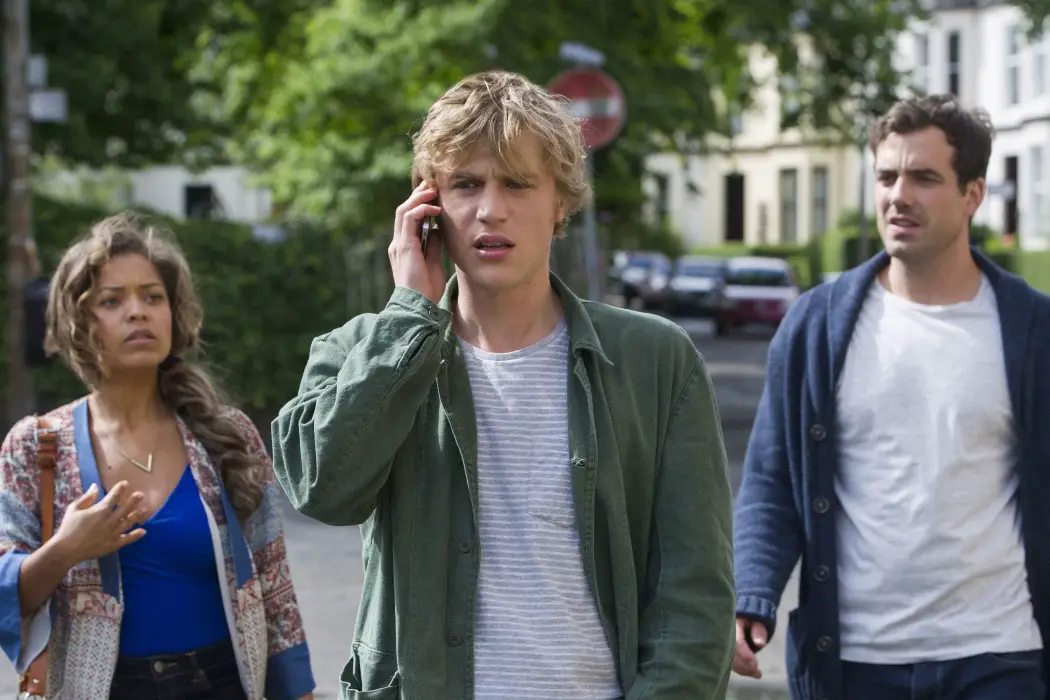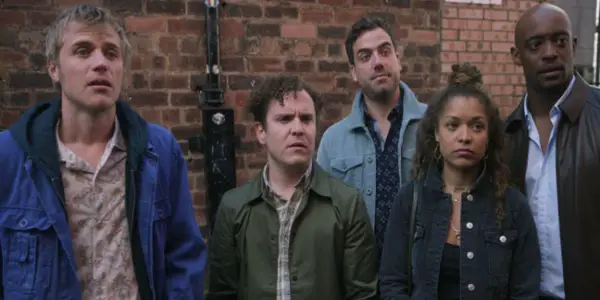LOVESICK: The Best Netflix Show You’ve Never Seen

Andrew Young is a freelance writer on film and culture…
It is sometimes possible to guess whether a new TV series is going to be a Netflix hit or not. Not in terms of critical praise, but in word-of-mouth buzz and streaming figures. Key things to look out for include: how easy the show is to market; how outrageous or ‘bingeable’ it is; how many famous/attractive people are in it; and how easily ‘memeable’ it is. Lovesick ticks virtually none of those boxes. Perhaps that is why the show has never found the widespread love it so greatly deserves.
Tom Edge’s sweet, heartfelt romantic comedy is not exactly under-appreciated; it ran for three critically-acclaimed series and is frequently the subject of evangelical articles such as this one. But stop your average Netflix subscriber in the street and they likely streamed Tiger King or The Stranger over Lovesick.
It is somewhat surprising that the British series never got close to being a mainstream smash, given how broad and accessible it is. There’s nothing niche or experimental about Lovesick; it comes in 20-odd minute episodes; it makes you laugh and it makes you cry. It ticks all the boxes of a good TV comedy-drama, just with more brains and heart than some of the others around it.
A Change of Heart
Before its move to Netflix, Lovesick ran for one series on Channel 4 in the UK, to a relatively small viewership. That may have had something to do with the title. You see, Lovesick was not always called Lovesick, but was for a while known as ‘Scrotal Recall’. It was a moniker that, whilst actually being quite a good joke and appropriate for the show’s premise, completely mis-sold its tone and intentions.

With its set-up, Lovesick could easily have become the gross-out sex comedy that ‘Scrotal Recall’ suggests. Episode One opens with Dylan (Johnny Flynn) telling his best friend Luke (Daniel Ings) that he has been diagnosed with chlamydia. Dylan now has to contact every woman he has ever had sex with to tell them the news.
From here, Lovesick tackles one encounter per episode, flashing back months or years to Dylan’s variety of one-night stands and failed relationships. At the same time, the episodes progress through the ‘now’ timeline and the ever-evolving ‘will they, won’t they’ between Dylan and Evie (Antonia Thomas), the third member of their best friend trio.
The whole thing is extremely warm, likeable, and frequently funny. Supporting characters like foolish, tiny Angus (Joshua McGuire) and party-animal Jonesy (Yasmine Akram) bring big laughs, but the show’s heart always lies in the friendships at its centre. Essentially a classical rom-com a lot of the time, Lovesick uses Dylan and Evie’s relationship as the emotional through-line for all three series, even if the narrative is supposedly held together by Dylan’s diagnosis.
Dylan is the kind of bumbling, attractive-yet-awkward hero we are used to seeing in a rom-com, never meaning to cause hurt but making a seemingly endless stream of bad decisions. Evie is sweet, kind and continually conflicted about her feelings for Dylan. Luke, meanwhile, is a womanising joker, never sticking with a relationship but fiercely loyal to his friends.
If these sound like three romantic comedy archetypes, that’s because they are. But Edge moves them way beyond this point in his writing. Dylan and Evie’s relationship brings out the best and the worst in both of them, helping to make them into well-rounded, believably human characters. Luke’s laidback, carefree personality gets nice development through the series too, his hidden depths being probed in unexpected and touching ways. Through it all, Flynn, Thomas, and Ings have great chemistry and each bring wit and charisma to three distinctly loveable protagonists.
The two-timeline structure is key to what makes Lovesick different, and so engrossing. As we try to piece together how Dylan, Evie, and Luke got to where they are today, the show takes on an unexpected air of mystery. It pulls off the trick of entertaining you like a comedy, but hooking you in like a good drama. More than this, though, our glimpses of Dylan’s past encounters allow us to understand our leads a lot better.
Usually when telling a story, a writer will inform us of a central character’s backstory to help us understand why they behave the way they do. Far more effective, however, is for us to see it for ourselves. The details of Dylan and Evie’s relationship in the present-day timelines are revealed to us piece by piece through their shared past. We begin to understand more of who feels what and why. Although Lovesick is nominally traveling back through Dylan’s past, his friendship with Luke and Evie means that they are just about always present for the shenanigans too.

The Ghosts of Dating Past
When watching romance on screen, things often happen quite quickly. There’s a meet-cute, the start of a relationship, a spanner in the works, an apology, and then a happy ending. In telling a story over several years, Lovesick explores the more realistic messiness, false-starts, and mistakes of modern love. It allows time for proper heartbreak amongst the sweetness, not just a quickly-resolved bump in the road.
If all of this sounds a bit serious for what is usually sold as a comedy, then fear not. The show’s structure may allow for deeper character insight, but it also makes space for a litany of dating disasters. From embarrassing sexual stories to failed attempts at being a ‘proper adult’, Lovesick finds humour in both the meaningful and meaningless romances in Dylan’s life. With the longer timeline, Lovesick can revel in relationships that go so awry that there is no coming back, dating catastrophes that help mould the characters into who they are today.
The show’s episodic structure is such a smart move because it embraces the opportunity television offers to simultaneously tell shorter and longer story arcs. Lovesick mines this for all its worth, giving us fresh bite-sized chunks of comedy every episode, combined with a stronger, more deeply felt romance over the course of the whole story.
Big Screen vs. Small Screen
The romantic comedy, as we know it, has typically been the preserve of the big screen. Warm, fuzzy, and neatly tied up in a bow come the end, a rom-com seems perfectly suited to the world of 90-minute storytelling. What is so wonderful about Lovesick, is that it takes what is essentially a fairly traditional rom-com and elongates it. A family drama, or a twisty-turny thriller might seem like obvious choices to spread over more time, but the rom-com has rarely been done on television. Instead, romance is usually plugged into a traditional sitcom format.
Yet, in telling a longer, more in-depth story, Lovesick plays with the classic rom-com formula and, arguably, elevates it. The rom is more believable, and more heart-rending; the com is funnier, with the space to fit in wholly humorous plotlines and asides. Lovesick uses its extra hours well, taking what are usually fairly one-dimensional movie tropes, and breathing real life into them, in doing so proving the compatibility of the television and the rom-com.

Compare the show to the work of cinema rom-com king Mr. Richard Curtis, for instance. In his films, we have a central love story, usually from the perspective of the man, and surrounding it a host of hilarious, larger-than-life characters. Think Spike in Notting Hill, or just about everyone in Four Weddings and a Funeral. This formula is reliably entertaining but, if not done well, it can become flat. Lovesick avoids all of these pitfalls, largely just through giving itself more time to tell its story.
The core relationship element running through Lovesick is initially from Dylan’s perspective, but Flynn and Thomas are really co-leads. A romance usually works better if we really know and understand both participants, and Edge has equal interest in the pair. On top of this, the ‘best friend’ archetype is here a proper, well-rounded character. Throughout, Lovesick is a proper three-hander in a way you do not get at the cinema.
The show doesn’t stop there either. With the likes of Angus and Jonesy, Lovesick utilises a full ensemble of entertaining characters. The trick to the series’ success is that this doesn’t detract from the central love story. Too often in a romantic comedy film, the makers appear to have made a choice between the romance and the comedy. Look at Four Weddings; the best parts of that film are essentially everything but the romance – Simon Callow’s flamboyant pronouncements, John Hannah’s funeral speech, James Fleet’s bumbling idiocy. It’s all great, but they are padding around a quite dull love story.
Lovesick, in being a TV series, doesn’t have that problem. It can build the comedy into the romance more comfortably, can give its peripheral characters something to do beyond pratfalls and wise-cracks. If there is an argument that Lovesick is not really a traditional rom-com at all, it is that there are multiple love stories going on at the same time, even if they are all surrounding the same one.
A series like this doesn’t just fill the place of a movie romantic comedy. Its length and commitment to showing the messiness of its relationships means that it lacks the definitiveness and neat satisfaction of a Hollywood ending. We have seen too much of these characters to not assume they will keep on living full and complicated lives long after we leave them. What the show lacks in the easy charm of simplicity, it makes up for in a deeper emotional connection. Lovesick doesn’t replace the rom-com, it just offers a new, often improved, take on it.
Have you seen Lovesick on Netflix? Has this article made you want to? Let us know your thoughts in the comments!
Watch Lovesick
Does content like this matter to you?
Become a Member and support film journalism. Unlock access to all of Film Inquiry`s great articles. Join a community of like-minded readers who are passionate about cinema - get access to our private members Network, give back to independent filmmakers, and more.
Andrew Young is a freelance writer on film and culture from Manchester, UK. If you like his writing, Andrew also runs a more informal film website at reeltime.blog













